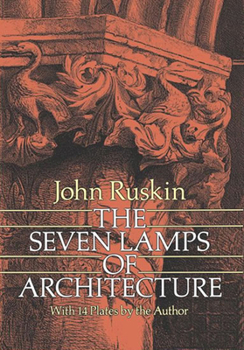The Seven Lamps of Architecture
Select Format
Select Condition 
Book Overview
Classic work by great Victorian expresses his deepest convictions of the nature and role of architecture and its aesthetics. Authoritative edition includes reproductions of 14 plates of Ruskin's architectural drawings.
Format:Paperback
Language:English
ISBN:048626145X
ISBN13:9780486261454
Release Date:December 1989
Publisher:Dover Publications
Length:266 Pages
Weight:0.86 lbs.
Dimensions:0.5" x 6.5" x 9.2"
Customer Reviews
4 ratings
Be forewarned: Unashamed moralizing and aesthetic certainty
Published by Thriftbooks.com User , 21 years ago
If you are looking for a "practical guide to thestructures and tools" of architecture, this is NOTyour book nor your guide. For John Ruskin is an art critic, classicist, andmoralizing aesthetic prophet. He is not an "art for art'ssake" temporizer or relativist. He not only knows whatHE believes...but he believes he knows what YOU shouldbelieve too. If that makes you uncomfortable or makesyou feel hampered, you might want to pass him by untilyou feel you can accommodate the "insult" and "restrictions"on your "free will choices." Otherwise, there is much ofbeauty, wonder, and insight to be gained in these pages. Ruskin's point of view is that of a classical Platonistmixed with the moralizing tenor of an exhorting (but notshrilly so) prophet toward beauty, Truth, and clarity ofvision...and moral purpose in Art. He also has a wondrousprose style which is both clear, compelling, and entrancing. This edition published by Dover as a reprint is of thesecond edition of the work from 1880. It also includes14 plates of drawings which Ruskin did to illustrate thepoints which he makes in the text. Along the way, Ruskin includes shortened Aphorismsin the margin which restate the bold face print pointswhich he is making in the text. In Chapter 2, titled"The Lamp of Truth," Ruskin stands forth most forcefullyand dynamically (and perhaps to the "modern," mosttendentiously) as the classical Platonic moralizerand aesthetic apostle/prophet/priest. Though raiseda strict Protestant, Ruskin rebelled and left Christianityfor a classical Paganism based on beauty, Truth, and clarity.Needless to say, this more than tended to alienate himand isolate him from the mercenary, industrializedVictorian world which was chugging along outside hishermetically sealed temple dedicated to Truth, Beauty,Goodness, and Clarity. Mercantilism and "practicalprogress" don't exactly exalt those four princples asthe means or the goals whereby to make money and becomesuccessful in the eyes of the world or popular opinion. But if you want to read about Truth and Beauty andread it through the eyes and soul of a lover of thosequalities -- and read it expressed in most beautifulprose and style (which is both poetic and powerful),then Ruskin and this work are clearly the choices youshould make. This excerpt from Ruskin tied to Aphorism 29 {"Theearth is an entail, not a possession.") clearly showsthat Ruskin's vision and prophetic power extend beyondthe merely practical realm of architecture into anall-encompassing total vision of responsibility andreverence: "The idea of self-denial for the sake ofposterity, of practising present economy for the sake ofdebtors yet unborn, of planting forests that our descendants may live under their shade, or of raising cities for future nations to inhabit, never, I suppose,efficiently takes place among publicly recognized motivesof exertion. Yet these are not the less our duties; noris our part fitly sustained upon the earth, unless the range of our
Architecture's Most Influential Written Work
Published by Thriftbooks.com User , 23 years ago
This book is the origin of virtually every theory held throughout the history of architecture. The arts and crafts movement, Frank Lloyd Wright's organicism, and Corbusier's New Architecture are just a few examples of prominent theories whose foundations lie within the pages of this book. In this book, Ruskin prescribes the essential elements required to make timeless, meaningful architecture. This manifesto is a must for any student interested in the practice and study of architecture.
Wonderful architectural moralism
Published by Thriftbooks.com User , 24 years ago
Ruskin is a master in morality and architecture. This combination, which is very nineteenth-century-like, mixes Ruskin with a wonderful mastery of the English language. The Seven Lamps is a must-read for all you folks who have not yet studied architecture in all its facets.
Lamps for everyone
Published by Thriftbooks.com User , 24 years ago
I first got this book to help study the principles of architecture and found that I could use the concepts in my everyday life. I am currently a student of architecture at WSU and found that the observations Ruskin was making about architecture 150 years ago still applied today. The seven "lamps" mentioned in his book not only apply to architecture, but can also be utilized in almost any field of study or occupational setting. The writing is wonderfully done and ideas are clearly presented to the reader. This is the type of book you get done reading and have a genuine desire to be better at everything you do.





